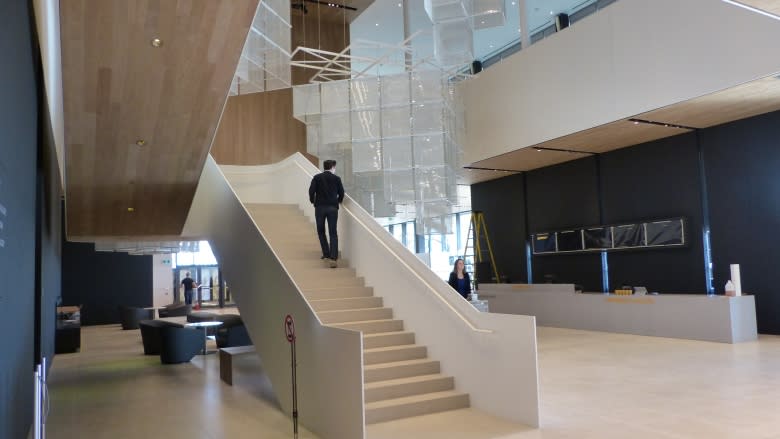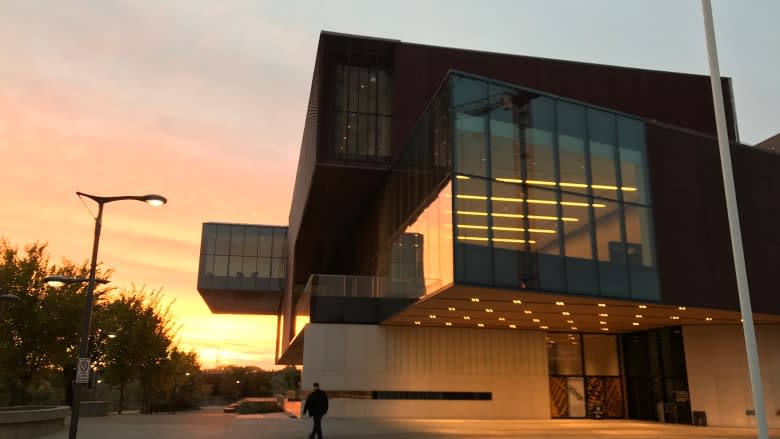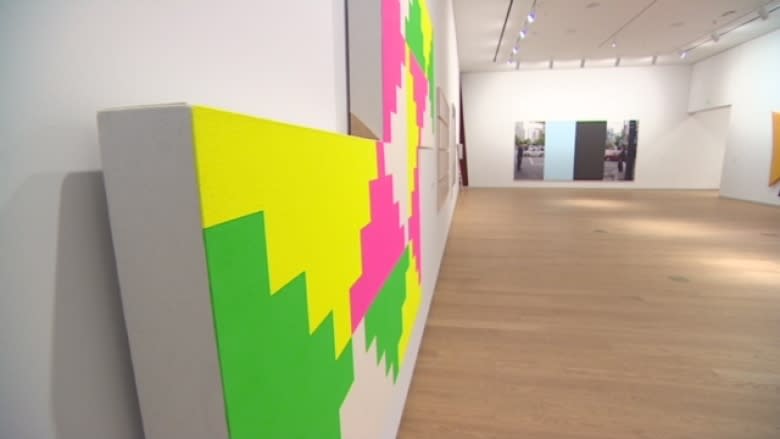The Remai Modern is complete — but will they come?
Nestled on the shoreline of the South Saskatchewan River, a 130,000-square-foot building constructed of metal and glass is a statement.
It's an impressive structure and one the City of Saskatoon hopes will anchor its downtown river development, River Landing.
It is one of the most anticipated art galleries in the country. The New York Times describes it as a "splashy new museum" in a "surprising locale."
But for the people who live in Saskatoon, opening day for the Remai Modern will be anything but a surprise.
The idea of building a large-scale destination centre on the edge of the riverbank alongside one of the most valuable pieces of real estate in the country had been percolating for more than a decade.
Ten years ago, some thought that destination would be something like Seattle's Space Needle; others envisioned a music hall of fame or an Imax Theatre.
In the years since, that vision evolved into one of the most expensive and ambitious mega projects the city has ever seen.
After years of delays, controversies and cost overruns, Saskatoon and the rest of country is about to get a glimpse inside.
The CEO of the new gallery says he wants the Remai Modern to become "a legend," an agenda-setting gallery that will be a "talking point not only for Saskatoon, but Canada."
But is Saskatoon, a city with a population just north of 250,000 people ready for an art gallery of this size and scope? Will there be enough support not only from the local arts community, but from the general public to keep the multimillion-dollar gallery afloat?
Art critic 'cautiously optimistic'
Gregory Burke, the gallery's CEO, says he hopes the gallery attracts not only the admiration of locals, but guests from around Canada and the world.
But, according to people familiar with Canada's art scene, large, impressive buildings may not be enough to ensure the success of an art gallery.
"When you spend a lot of money on a building renovation or a new building that is a significant cost that cost needs to be offset by attendance," said David Balzer, an award-winning critic, editor and author who edits Canada's most widely read art magazine, Canadian Art.
"We are living in a time where there is not a lot of faith institutionally of people leaving their homes, leaving their screens in droves to go see art shows."
Balzer said he is "cautiously optimistic" that the Remai will succeed in Saskatoon — that people will come; that the gallery will be able to meet its target of attracting more than 220,000 visitors a year by its third year of operation.
The caution is a key, he said. Success in the art gallery world, Balzer said, is a delicate balance. An art gallery dedicated solely to meeting attendance targets and recouping costs always runs the risk of trying to pander, trying to get people in the door instead of challenging them with provocative and important art.
So, he said, "the programing will become less challenging; the programing will make assumptions about what it thinks people want to see; the programing will become vulgarly populist and, in that sense, not really be about art all and, in addition to that, alienate local communities."
Artists close to the project are confident that will not happen.
"There are people there that I trust who won't turn it into something for the masses," said Alison Norlen, an artist, professor and recent member of the Remai board.
Norlen, like many artists in the local arts scene, are waiting with bated breath for the gallery's great unveiling.
She said while the numbers — the construction costs, attendance targets — are real, that shouldn't be the primary focus; art and the experience of art should be.
"I'm massively excited. I travel a lot to see lots of different museums and galleries and this is the equivalent to the places I leave town for," she said.
History of cost overruns cast shadow over gallery opening
But for much of the general public, the numbers are what defined the debate around this gallery. The construction costs have skyrocketed in the eight years since the gallery was announced. Originally pegged at $55 million, the cost is now over $100 million if you include an underground parkade being built alongside.
This week, Mayor Charlie Clark had to answer questions about the gallery costs. It's expected to cost $5.4 million to staff and maintain the gallery, but the city's annual budget warns that number could rise.
"We've tried to be transparent all along — that this is going to have an impact. It's 3.5 times larger building than what the Mendel was, and the budget is not 3.5 times larger," Clark told reporters after the first draft of the city budget was presented to councillors earlier this week.
One way the gallery hopes to recoup those costs is by charging admission fees, unlike its predecessor. Burke said that's necessary.
"We couldn't have operated on the budget that was projected at that point. It was five times the size of the Mendel gallery, it's a very sophisticated building and it costs a lot to operate," Burke said.
Clark said he wants the world class gallery to be part of what attracts people and keeps them living in the city.
To do that, according to some, the gallery needs to embrace the local arts community.
Local engagement key to success, artists and critics say
Canada-wide, Balzer said, Saskatoon has a well-known reputation for having a thriving, artist-driven, co-operative art scene.
The Remai, in his mind, needs to embrace that sense of community and unique locale if it's going to survive. He said the Remai needs to fit into the "ecosystem" of Saskatoon's art scene and cannot simply rely on outsiders coming in.
"If the ambition of an institution like that is to bring people from outside the city, from outside Saskatchewan to visit, that is very flawed and probably inevitably failed ambition because of the nature of Saskatoon — where it is, what is all about," he said.
"It's not really about displaying works by Picasso; it's about more than that."
Renowned local artist Marie Lannoo agrees the Remai needs to be mindful of the local art scene.
"It's just going to attract the outside world and the inside world — the inside world meaning the artists here, the local community. It raises the bar for everyone and I think that's a really positive thing," she said.
Saskatoon ready to take the leap: artists
Lannoo admits the gallery's price tag and the need to attract a wide audience present some challenges. But she believes the city and its people are ready to take those risks.
"Saskatoon just seems to be at an interesting evolutionary point at the moment, and I think the gallery is coming at a really great time as the city is coming into its own and hitting its stride. And I think the gallery will contribute that," she said.
Norlen has a big vision for the gallery. She said while people might come in to see artists they recognize — the Picasso prints for example — they will leave changed. Art, she said, can be transformative and so, too, can this gallery for this city.
"For a city this size there is nothing comparable in Canada. I think it's going to be a landmark. It's a good seeking out for the future," she said.
Balzer said a true measure of the gallery's success won't necessarily be attendance figures. It'll be how the Remai, a massive facility, reaches out to the people who live in Saskatoon and engages with them. If a new generation becomes engaged in art because of the work of the Remai, the gallery, in his mind, will be a success story.





